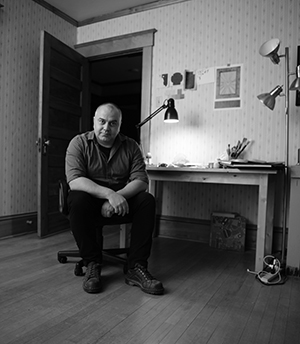Above: “Circuit Floorplan #57” by artist Tibi Chelcea; metallic ink and colored pencils on paper. The drawings in the series are inspired by the stage that takes place between the schematic and physical layout portions of creating a circuit board.
Writer: Sophia S. Ahmad

Artists draw inspiration from everywhere: Da Vinci from the human form, Monet from water lilies. Then there’s Romanian-born Tibi Chelcea, who uses his training as an electronic engineer to create distinctive works that explore how technology interacts with our perceptions of time, space and beauty.
His diverse portfolio ranges from illuminated manuscripts of scientific research to colorful electronic circuit boards to a Twitter account that tweets a daily preprogrammed computer script.
Chelcea, 46, moved to the United States in 1997 to study at Columbia University. After he received his Ph.D. in computer science, he worked at Carnegie Mellon University in Pittsburgh. There, he met his wife, Amy Erica Smith, and in 2012 they moved to Ames, where she teaches political science at Iowa State University and where he is a software engineer at AgLeader Technologies. In the evenings, after their two children, ages 6 and 9, are tucked into bed, Chelcea turns to his art. He commits 10 to 14 hours a week to his craft, a practice he began about 10 years ago.
“His attention to detail and his work ethic are amazing,” says fellow artist Robert Schulte, a framing and installation specialist at Moberg Gallery. “There’s no margin for error; he is so precise with it. You look at his pieces and wonder if they’re done with a computer.”

Circuit Board Drawings
Chelcea’s ink and colored pencil “Circuit Floorplan” drawings (pictured right and on page 105) are inspired by the “floor-planning stage” that takes place between the schematic and physical layout portions of creating a circuit board. This step indicates where functional circuitry appears on a board.
“His drawings are flawless, and he has the craftsmanship,” Schulte says. “When you look at Tibi’s work, there’s intention in everything he does.”
In many ways, Chelcea’s art acknowledges the hours of effort that engineers spend designing products, even those devices that are short-lived. Through Chelcea’s artistic process, the instantaneous nature of these technologies is expanded into what he calls “a meditative experience.” This is especially true of his “PCB Drawings” (printed circuit board) collection (see images, page 109 and 110).
The creation of these pieces, Chelcea says, “is very calming for me. You just get into the flow and it is easy.”

In this series, he creates non-utilitarian circuit boards from scratch in ways that emphasize their precision, intricacy and beauty. The works are meticulously designed through computer software and then are sent to an electronics company for manufacturing. Factories typically have a minimum order quantity; in a way, this process emulates the printmaking tradition of creating multiple identical works.
Artful Tweet
Frequently, Chelcea’s pieces reimagine time, scale and space. In “One Second (Tweeted),” the artist expresses his fascination with microprocessors and pays homage to how much they can accomplish in just one second of time. He wrote a custom web development script for a Twitter account (@OneSecTweeted) that over the course of more than 1,200 years, will continuously tweet out the 433 million assembly instructions that are executed in just one second on a Windows PC.
“People don’t think about what’s happening in technology,” Chelcea says. “It kind of just works, and good technology kind of makes you forget.”
As he says in his artist statement: “My artworks urge people to appreciate all this hidden technology not only as something utilitarian, but also aesthetically, and to reconsider the speed of life these electronic products enable by placing [them] on radically different time scales.”

Chelcea ventures into other mediums as well. His “Origins” series converts all 24 frames from one second of the 1997 film “Titanic” into a lithograph series consisting of two dozen works. The “Trigonopoetry” series reshapes textbook meaning. In the creative process, specific words are protected by masking tape, then the entire page is painted over, and the tape is removed to reveal a new meaning. Chelcea recently expanded this concept by inviting local musicians to pick a phrase from the trigonometry textbook. He then creates a painting, and the musicians compose a song using the same text.
Chelcea’s exploration of the intersection of science, art and life is perpetual. “I like to play with ideas and I like to find outlets for them,” he says. “And, when I find outlets that inspire me, I want to explore them from different angles.”








